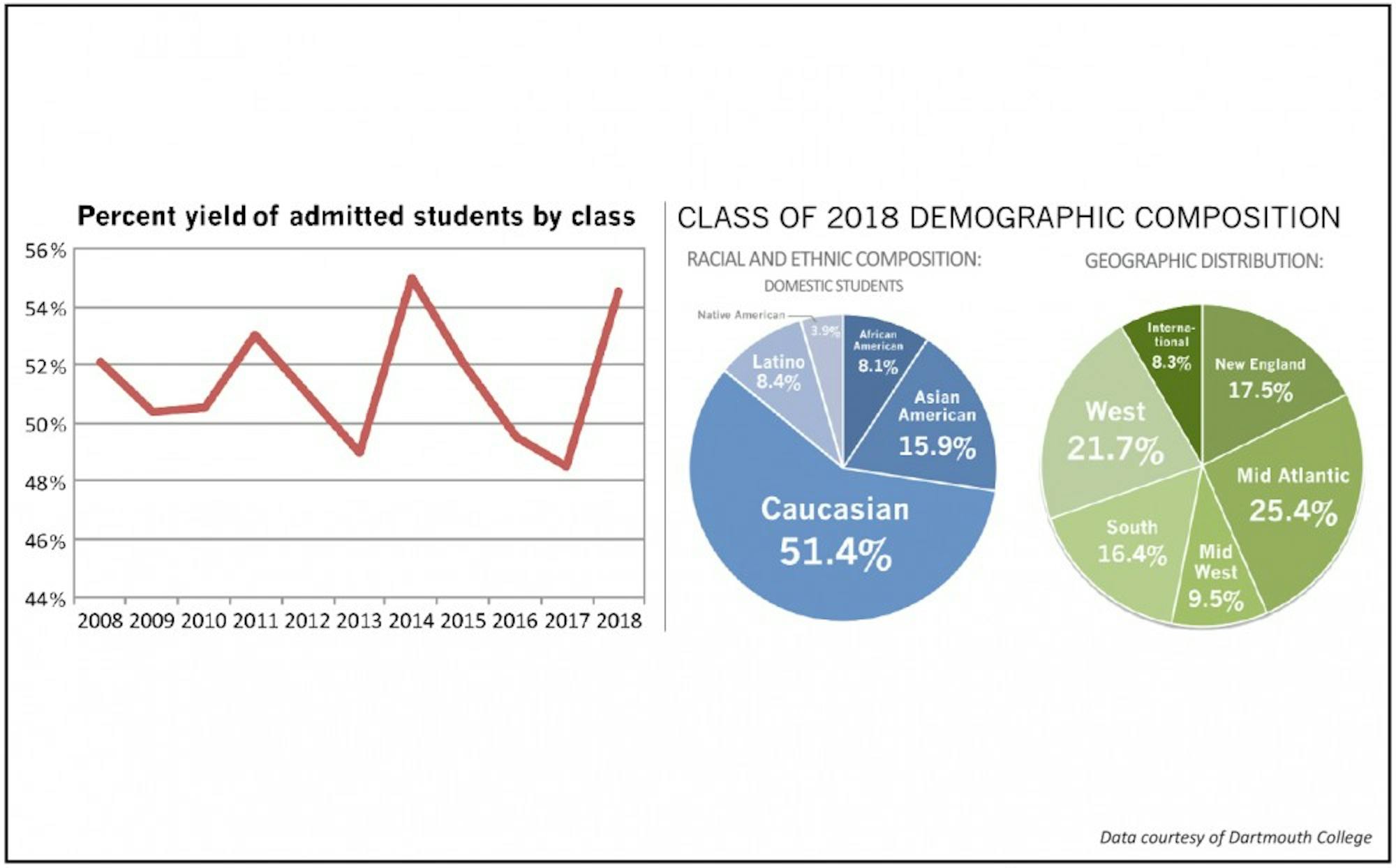With a yield of 54.5 percent for the Class of 2018, the number of students accepting Dartmouth’s offer of acceptance is the highest it has ever been, the College announced Monday. To accommodate this influx, Dean of Admissions Maria Laskaris said, the College does not plan to admit any students off the wait list and plans to halve the number of transfer students it expected to accept.
The higher yield follows a 14 percent drop in total regular decision applications from last year. This year’s yield increased from last May’s yield of 48.5 percent, when 1,093 students accepted the College’s offer of admission.
The total number of students accepting Dartmouth’s offer this year, which is 1,210, is higher than the 1,187 students who accepted Dartmouth’s offer to join the Class of 2014 in May 2010. The yield in May 2010 was 54.7, slightly higher than this year’s yield of 54.5 percent.
Of the 1,854 students placed on the wait list this year, about 900 have asked to remain active, Laskaris said.
The Class of 2018 currently comprises 90 students above the projected class size of 1,120. The College will admit around 15 transfer students, rather than 30 as anticipated, Laskaris said.
With a class composition of 50.8 percent men and 49.2 percent women, the incoming class hails from 872 different high schools, according to information provided by Laskaris. About 55.3 percent are public school students.
Among the students who have committed to attending the College, 11.2 percent are first-generation college students and 8.4 percent are Latino, each the largest representation of that group the College has seen in an incoming class. Legacy students make up 12.7 percent of the class. Comprising 8.1 percent of the incoming class, African American students are more represented than they have been in the past five classes. Native American students will make up 3.9 percent of the class, while Asian American and Caucasian students make up 15.9 percent and 51.4 percent, respectively.
Last year, approximately 37 percent of students who accepted offers to the Class of 2017 by the May 1 deadline were students of color and 9 percent were international students. International students make up 8.3 percent of the Class of 2018.
Around 44 percent of the incoming class will receive financial aid, compared to approximately 46 percent last year.
In the past decade, the admissions yield has consistently remained at roughly 50 percent, while the number of applicants increased to 22,416 students in 2013 from 11,855 in 2003. This year saw 19,235 total applicants.
Of this year’s accepted students, 469 students were admitted early decision, representing about 38.7 percent of the total class.
Because around 50 students each year decide to either take a gap year or accept a spot off of another school’s wait list, the precise composition of the Class of 2018 will likely shift as September approaches, Laskaris said.
“The class as it stands right now is a phenomenal result for Dartmouth,” she said.
The shifted structure of Dimensions likely contributed to the increased yield, Laskaris said. Around 1,300 people combined attended the three Dimensions events this year, compared to 800 who attended the single Dimensions weekend last year.
The College will likely continue to hold multiple Dimensions events next year, Laskaris said.
Laskaris said the 12 admitted student events held nationwide, drawing more than 500 students total, were factors in the increased yield. Additionally, student admissions interns tried to reach out to admitted regular decision students individually.
After an early decision cycle where the number of applications rose 6.7 percent and 469 students were admitted, the drop in regular admission applications was a surprise, Laskaris said.
The national publicity about student life and campus climate brought “unprecedented” yield challenges, Laskaris said in an email.
Recent news, including that of the anonymous $100 million gift to the College and Dartmouth’s efforts to combat sexual assault, prompted the admissions office to feel “a real shift in momentum,” Laskaris said in an email.
Seven members of the Class of 2018 interviewed said attending Dimensions led them to choose Dartmouth.
Marcella Saboe ’18 and Sai Mupparaju ’18 both cited experiences sitting in on classes and talking with professors at Dartmouth as key factors in their decisions.
Justin Sanders ’18, who said his time at the third Dimensions “sealed the deal,” said that multiple Dimensions events allowed him to choose a visit that worked best for his schedule.
Eight members of the Class of 2018 said that they felt Dartmouth’s handling of and response to recent media attention has been encouraging.
Allie Fudge ’18 said that while she “struggled” with negative publicity about Dartmouth, she was won over by Dartmouth’s active attitude toward combatting campus issues.




